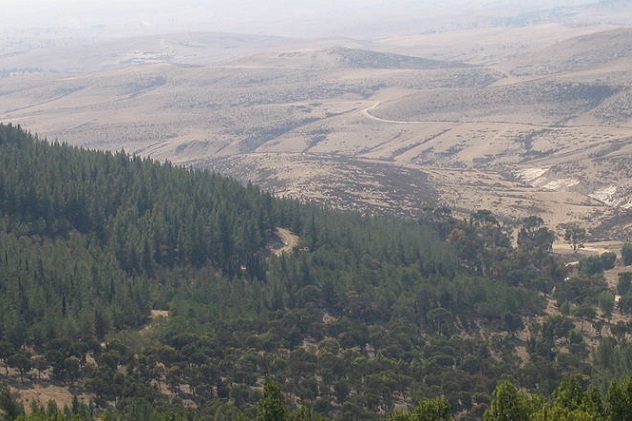 Humans
Humans  Humans
Humans  Movies and TV
Movies and TV The 10 Most Heartwarming Moments in Pixar Films
 Travel
Travel Top 10 Religious Architectural Marvels
 Creepy
Creepy 10 Haunted Places in Alabama
 History
History Top 10 Tragic Facts about England’s 9 Days Queen
 Food
Food 10 Weird Foods Inspired by Your Favorite Movies
 Religion
Religion 10 Mind-Blowing Claims and Messages Hidden in the Bible Code
 Facts
Facts 10 Things You Never Knew about the History of Gambling
 Weird Stuff
Weird Stuff 10 Cool and Creepy Facts about Collecting Tears
 Humans
Humans The Ten Most Lethal Gunslingers of the Old West
 Humans
Humans Ten Historic Men Who Deserve Way More Credit Than They Got
 Movies and TV
Movies and TV The 10 Most Heartwarming Moments in Pixar Films
 Travel
Travel Top 10 Religious Architectural Marvels
Who's Behind Listverse?

Jamie Frater
Head Editor
Jamie founded Listverse due to an insatiable desire to share fascinating, obscure, and bizarre facts. He has been a guest speaker on numerous national radio and television stations and is a five time published author.
More About Us Creepy
Creepy 10 Haunted Places in Alabama
 History
History Top 10 Tragic Facts about England’s 9 Days Queen
 Food
Food 10 Weird Foods Inspired by Your Favorite Movies
 Religion
Religion 10 Mind-Blowing Claims and Messages Hidden in the Bible Code
 Facts
Facts 10 Things You Never Knew about the History of Gambling
 Weird Stuff
Weird Stuff 10 Cool and Creepy Facts about Collecting Tears
 Humans
Humans The Ten Most Lethal Gunslingers of the Old West
10 Societies Buried Beneath Your Feet
While most of us go about our socially acceptable lives, whole societies exist below the streets, full of people living an unconventional and oftentimes hazardous lifestyle. Some are down there by choice, while others have none. Some have cleared out, but others still reside. The only thing they share is that at some point, they adopted a home beneath the Earth’s surface, and society remains largely unaware of the people right below their feet.
10Bucharest, Romania
Below the streets of Romania’s capital of Bucharest is a network of tunnels providing shelter for a group of drug-addicted, HIV-infected, and chain-wearing kids and teenagers. Their leader—or rather, father figure—refers to himself as “Bruce Lee” and takes in the lowest of the low. He’s dedicated his life to keeping his self-sufficient family safe and as warm as possible, even if that means giving them a safe space to do drugs. The teens can often be seen huffing metallic paint out of black bags called Aurolac.
The front door to this underground community is a hole in the pavement on a traffic island, and no one can enter without permission from Bruce Lee himself. Those who have been invited describe it as a type of parallel universe, a world of abandoned children and addicted teenagers, rescued dogs and cats, full electricity, a stereo system that plays nonstop club music, televisions, and even artificial grass.
Citizens of Bucharest are not only aware of what’s going on beneath their feet, many praise Bruce Lee’s actions. After the 1966 ban on contraception and abortion by former communist leader Nicolae Ceausescu in an effort to increase the workforce, unwanted and orphaned children began flooding the streets. Bruce Lee has not only moved these tragic youths off the streets, he’s provided a safe haven for those who would otherwise freeze in the brutal temperatures or fall victim to sexual predators. He even pays protection money to a local gang to ensure his children’s safety. While the homeless children of Bucharest remain hidden from the public eye, Bruce Lee hopes for them to be recognized as the self-sustaining family that they strive to be.
9Ulan Bator, Mongolia
As Mongolia transitioned from Soviet socialism to capitalism, many citizens were left homeless and unemployed. As a result, parents were given little choice but to abandon their children. Since winters in Ulan Bator can drop to a brutal – 34 degrees Celsius (–30 °F), the 4,000 runaway or abandoned children in the city of 2.5 million began to seek refuge in the sewer system, where the city’s hot water pipes snake through intricate underground tunnels.
Through the work of international and local groups, many of these children were rescued from the sewers, but the adults who had made a home in the tunnels were left untouched and ignored. Witnesses describe the residents of this subterranean refuge as derelicts who spend their days drinking 200-proof Mongolian moonshine, wasting away in a drunken stupor while futilely trying to provide for their families.
Life for these subterranean Mongolians isn’t easy. While the water pipes and alcohol may provide an escape from the intense cold, the sewers can actually get fatally hot. This has led to the deaths of many who have nowhere else to turn to escape the freezing temperatures of Mongolia.
8Kazan, Russia
During the investigation of a terrorist attack that had killed a top cleric in the region of Tatarstan, police discovered an eight-level bunker beneath a mosque in Kazan, Russia. There, they found an Islamic sect of 27 children and 38 adults living in monk-like chambers. Many of these children were kept in unheated cells and had never visited a doctor, attended school, or seen daylight.
The labyrinth-style bunker was the brainchild of 83-year-old Faizrakham Satarov. In the mid-1960s, after he noticed sparks shooting from a trolleybus cable and interpreted them as divine intervention from God, Satarov declared himself an Islamic prophet and built the bunker as a religious school. His followers eventually secluded themselves inside, rejecting their former lives above ground and asserting themselves as an Islamic caliphate.
Upon discovery, Satarov’s devotees refused to abandon their underground Islamic state. They defiantly proclaimed that they’d have to be steamrolled by bulldozers along with the bunker, but it ended up being demolished without bloodshed. The children were given medical attention, proper care, and their first glimpse of sunshine.
7Yanan, China

Thanks to the permeable soil of the Loess Plateau in Yan’an, China, more than 30 million Chinese farmers have turned to cave-dwelling for sustainable living and agriculture. While the more elaborate caves are fortified with brick masonry and sport high ceilings and front yards, standard caves (called yaodongs) are composed of vaulted rooms dug into the side of a mountain. They have entrances draped in rice paper and quilts, and their walls are plastered white with lime and decorated with paintings and magazine clippings.
This style of living is energy-efficient, cost-effective, and a monument to a long history of Chinese cave-dwelling. For over two millennia, the Chinese people have adopted this lifestyle, from the earliest primitive caves of the Zhou Dynasty to the more evolved subterranean caves of the Qin and Han eras. Many caves are inherited property, passed down from one generation to the next.
Those who grew up in these yaodongs often never leave for their love of the cultivation, simplicity, cool summers, and warm winters. Lifetime cave-dweller 76-year-old Ma Liangshui says that “Life is easy and comfortable here . . . I have everything I need. I’ve lived all my life in caves, and I can’t imagine anything different.”
6Paris, France

Also known as the Empire of the Dead, the catacombs in Paris are an impressive, 320-kilometer (200 mi) underground cemetery. It is the eternal resting place for more than six million people. During a training exercise beneath Palais de Chaillot, across the Seine from the Eiffel Tower, Paris police stumbled across the headquarters of a secret society that was fully equipped with electricity, phone lines, and even restaurants and movie theaters. The ceiling was painted with swastikas, Celtic crosses, and stars of David.
Upon entry at the first tunnel, police found a closed-circuit TV camera sitting on a desk recording images of all entering the premises as well as a tape of dogs barking that was triggered to scare off intruders. The tunnel led to a cave 18 meters (60 ft) underground that was outfitted with a cinema screen, seats carved from rock, projection equipment, and a variety of films. In a smaller cave, there was a restaurant and bar fully stocked with whiskey, tables, chairs, and even a pressure cooker for couscous.
When police returned to the underground quarters a few days later to investigate the source of the electricity, they found the power and phone lines cut along with a note in the middle of the floor that read “Do not try to find us.” Following the mysterious discovery, a group of urban explorers who called themselves the Mexican Consolidated Drilling Authority admitted to RTL Radio that the cinema belonged to them. This underground organization secretly improves parts of Paris that are neglected by the French government. When they’re not restoring medieval crypts and the Pantheon clock, they gather together deep below Paris for film festivals and parties.
5Moscow, Russia
In Moscow, beneath the former site of the Cherkizovsky market that had been shut down in 2009, a police raid revealed 260 illegal workers living in an underground sweatshop. Many of these workers were Vietnamese, but others had migrated from the former Soviet Republics of Tajikistan, Uzbekistan, and Kyrgyzstan. Since the USSR was dismantled in 1991, these republics have struggled with poverty, forcing many to seek alternate and sometimes illegal means of survival.
According to a Human Rights Watch report, the migrants were forced to work long hours in poor living conditions with little to no pay. Due to the migrants’ poverty, limited Russian dialect, and lack of ability to contact Russian society to seek the necessary aid, workers were forced to live and build a community within the cramped and damp tunnels. Sewing machines, a casino room, a cafe, a chicken coop, and even a cinema were found among the sweatshop residents.
4New Kingston, Jamaica
Beneath the streets of a country that is bustling with tourism lies a society of disowned and abandoned teenagers who are forced into the sewers for shelter and protection solely because of their sexual orientation. With 85 percent of Jamaican citizens opposed to the legalization of same-sex marriage, homophobia is a cultural norm.
As a result, its gay citizens are subjected to repeated harassment, abuse, and murder. With nowhere else to turn, their sanctuary is a storm drain. Even there, they are a target of police raids. In one instance, police burned all of the food and clothing that had been donated to them because they suspected theft.
In the gullies, they section their rooms off with tattered sheets, sleeping on damp mattresses or cardboard boxes. Their living room is dark and muggy, the floors are scattered with trash, and the walls are decorated with graffiti. The storm drain floods with sewage when it rains, but if they go above ground they are met with death threats and subjected to rocks and trash being thrown at them. Unfortunately, the abusive environments of local shelters are actually worse than the storm drain, leaving many in the LGBT community with no choice but to call the sewers their refuge.
3Las Vegas, Nevada
Below the neon, gambling, and endless hordes of tourists that dot the streets of Las Vegas, there are 320 kilometers (200 mi) of flood tunnels that 1,000 people call home. Individual rooms are 37 square meters (400 sq ft) and furnished with double beds, wardrobes, showers, paintings, and bookshelves, all lifted off the floor with concrete slabs so they can withstand the tunnel’s constant flooding. Scraps of carpet are laid out to make the place feel more homey, and the whole tunnel system is like one big art gallery, covered in complex graffiti.
According to those who have interacted with the tunnel residents, many are recovering from post-traumatic stress disorder. They have sought solace in building a community beneath the streets of one of the United States’ most notorious cities, turning their struggles into productivity.
But why do so many seek out the scorpion-filled tunnels as their home? Las Vegas tends to ignore the homeless, preferring to keep them out of sight and out of mind. According to reports by The Sacramento Bee, Nevada’s primary psychiatric care center, the Rawson-Neal Psychiatric Hospital, has unloaded more than 1,500 homeless patients across state lines via Greyhound buses. The city’s apathetic attitude toward the homeless leads many of them to feel they have no choice but to retreat to the underbelly of Sin City.
Unfortunately, life beneath the streets takes a toll on many who are already suffering. Depression, addiction, and hopelessness is a way of life. The residents spend a majority of their time in damp and flooded conditions, having to constantly move their homes from space to space to avoid as much water damage as possible. Many of these underground residents search the casinos for leftover money, and one claims to have found a $1,600 winning sports ticket on the ground. Sadly, he used it to buy meth.
2Mount Hebron, Palestine

About 1,000 Palestinians live in the caves of South Mount Hebron in the southern West Bank. The residents who flock to these caves are thought to have been living this subterranean lifestyle for centuries. They are a self-sustaining society, surviving off farming and the production of milk and cheese for their personal use as well as for profit by selling them to surrounding villages. There are no paved roads, so the residents travel by foot, horse, or donkey. No running water or electricity exists for these cave-dwellers, and any healthcare or education is solely derived from the generosity of nearby villages.
In the 1970s, Israel marked off Mount Hebron as a military area, driving many of the residents out by destroying their homes and ignoring the violence inflicted on them by local settlers. Surveys of residents reveal that 88 percent of them report being victims of settler violence or having witnessed violence against a first-degree relative. These acts of cruelty include verbal and physical assault as well as theft of sheep and goats and even demolition of their water supplies. Unfortunately, many of these people are being driven out of caves that have been passed down through generations, forcing them to give up an important aspect of their heritage.
1Shoyna, Russia
The small Russian village of Shoyna, located on the banks of the arctic White Sea, was originally built in the 1930s as the base for a fishing fleet. In the 1950s, the village’s mossy terrain began to dust over with sand, and whole buildings were soon buried beneath the granular substance. The sand moved in quicker during the 1980s, leaving most of the village completely buried. Shoyna’s population dwindled from 2,000 to just 375, most of whom have to enter their homes through their attics, sometimes through manholes they’ve had to carve into their roofs.
While the cause of the sand dunes that have buried the village is relatively unknown, some believe it’s due to damage to the sea floor caused by fishing boats, which makes the sand start rising. Others believe that animals and trucks damaged the grass surrounding the village, allowing the sand to be dragged in by the wind.
Shoyna receives their water from one well, medical advice from one doctor, and most of their supplies from cargo ships. That’s because the sandy terrain is too extreme for delivery trucks, and it’s too expensive to fly supplies in. Since digging a house out with a tractor is far too expensive and dangerous for the house’s structure, many have accepted this submerged lifestyle, noting their appreciation for the freedom they have there.








